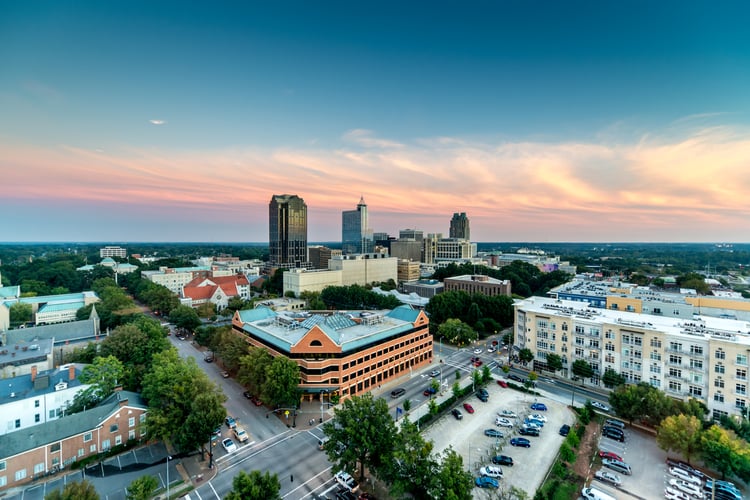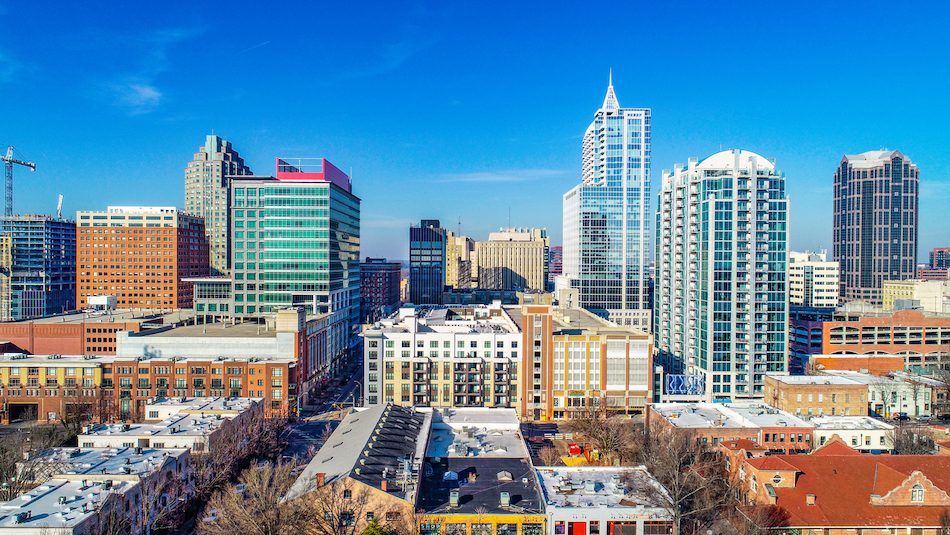Population growth and a thriving job market are 2 things investors look for when choosing a market in which to buy rental property, and the real estate market in Raleigh ticks both boxes.
Raleigh and nearby Durham are ranked among the fastest-growing places in the country, with the city of Raleigh alone growing by nearly 16% over the past 10 years, according to the most recent census.
Anchoring one corner of the Research Triangle, science, technology, engineering, and mathematics (STEM) jobs are on the rise in Raleigh, beating out traditional high-tech cities such as Boston and San Francisco for biotech employment and STEM job creation. Home prices in the metro area have increased by nearly 30% over the past 12 months, and many of the smaller towns in the region still have relatively affordable home prices and a good percentage of renters.
Key takeaways
- Home prices in Raleigh have increased by nearly 30% over the past year, which may be why many of the best places in the metro area have a good percentage of renters.
- Over the past 12 months, median rents for 3-bedroom homes in Raleigh have grown by 10%.
- Thirty percent or more of households in small towns near Raleigh, like Wendell and Zebulon, are renter-occupied.
>>Explore Roofstock's Raleigh investment properties.
Why invest in Raleigh?
Raleigh was ranked as the fourth best emerging housing market for investors in 2021, based on key performance stats, such as economic vitality and housing market activity. Looking at the most recent numbers, it’s easy to understand why.
According to Zillow, as of December 31, 2021, the typical value of a middle-price-tier home in Raleigh increased by 29.6% over the past 12 months, while rent prices for 3-bedroom homes in the metropolitan area increased by 10% year over year (Zumper as of February 7, 2022).
There are 75 Raleigh neighborhoods in which to look for investment properties, with median home listing prices ranging from $265,000 to more than $895,000.
The good news is that Raleigh is currently a buyer’s market, according to Realtor.com, which means the supply of homes is greater than the demand for homes. Of course, the balance between sellers and buyers could change at any time, as real estate markets frequently do, and homes here are still selling for approximately the asking price.

15 great areas in Raleigh for investment properties
To narrow down your search for investment property in Raleigh, we’ve put together a list of 15 areas worth considering. Data for the following places comes from Realtor.com, Redfin, and Niche.com, as of December 2021.
Holly Springs
Holly Springs is located southwest of Raleigh, between Fuquay-Varina and Apex. The area is ranked by Niche.com as the #1 Raleigh neighborhood in which to buy a house and has a sparse suburban feel:
- Population: 34,874
- Median sale price: $555,000
- Change in sales price (year over year): 30.6%
- Days on market: 34
- Median rent: $1,416
- Renter-occupied households: 17%
- Median household income: $112,029
- ZIP codes: 27539, 27540
Raleigh
Raleigh is ranked as one of the best North Carolina cities in which to live and the seventeenth best city in which to live in the entire U.S. The city is popular, has a mixed urban-suburban feel, and sees nearly half of the residents rent their homes:
- Population: 464,485
- Median sale price: $384,812
- Change in sales price (year over year): 21.0%
- Days on market: 34
- Median rent: $1,121
- Renter-occupied households: 48%
- Median household income: $106,221
- ZIP code: 27513, 27545, 27602, 27606
Fuquay-Varina
Located southwest of Raleigh, along Highway 401, Fuquay-Varina has a sparse suburban feel. The area receives an overall “A” grade from Niche.com and is ranked as the sixth best Raleigh neighborhood in which to buy a house:
- Population: 27,426
- Median sale price: $421,500
- Change in sales price (year over year): 28.2%
- Days on market: 34
- Median rent: $1,160
- Renter-occupied households: 28%
- Median household income: $79,000
- ZIP code: 27526
Garner
Garner is located just south of Raleigh and is bordered by I-40 on the east and Lake Benson Park on the south. The town has a dense suburban feel, a good percentage of renters, and is considered one of the best places to live in North Carolina:
- Population: 29,462
- Median sale price: $360,000
- Change in sales price (year over year): 30.9%
- Days on market: 35
- Median rent: $1,122
- Renter-occupied households: 34%
- Median household income: $65,064
- ZIP codes: 27529, 27603
Wendell
Located east of Raleigh, between Knightdale and Zebulon, Wendell has a sparse suburban feel and is ranked as one of the best places in the area to buy a house. Wendell is popular and more than two-thirds of the residents rent their homes:
- Population: 7,308
- Median sale price: $368,000
- Change in sales price (year over year): 22.0%
- Days on market: 35
- Median rent: $964
- Renter-occupied households: 35%
- Median household income: $59,236
- ZIP code: 27591
Morrisville
Morrisville is located south of the Research Triangle, at the intersection of I-540 and I-40. The town is ranked by Niche.com as the #1 neighborhood in which to live in North Carolina:
- Population: 26,280
- Median sale price: $446,000
- Change in sales price (year over year): 34.5%
- Days on market: 30
- Median rent: $1,398
- Renter-occupied households: 52%
- Median household income: $101,738
- ZIP code: 27560
Cary
The town of Cary is located west of Raleigh and south of Durham and Chapel Hill. Cary is ranked as the second best place to live in North Carolina, has a dense suburban feel, and has a good percentage of renters:
- Population: 166,268
- Median sale price: $501,000
- Change in sale price (year over year): 30.1%
- Days on market: 48
- Median rent: $1,246
- Renter-occupied households: 32%
- Median household income: $104,669
- ZIP codes: 27511, 27512, 27519, 27607
Apex
Located west of Cary along State Highway 1, Apex is ranked highly with an “A+” rating from Niche.com. Apex has a dense suburban feel, with one in 4 households renting rather than owning:
- Population: 51,370
- Median sale price: $513,350
- Change in sale price (year over year): 35.1%
- Days on market: 31
- Median rent: $1,380
- Renter-occupied households: 25%
- Median household income: $111,435
- ZIP codes: 27502, 27511, 27523, 27539
Wake Forest
Wake Forest is located northeast of Raleigh and is ranked as one of the best suburbs in which to live in the state. The town has a sparse suburban feel and has a good percentage of renter-occupied households:
- Population: 42,111
- Median home value: $456,130
- Change in sales price (year over year): 21.7%
- Days on market: 31
- Median rent: $1,117
- Renter-occupied households: 29%
- Median household income: $92,210
- ZIP codes: 27587, 27588
Clayton
Located southeast of Raleigh, Clayton has a spare residential feel and is ranked as the #1 place to live in Johnston County by Niche.com. The town receives good grades for housing and , nightlife and nearly 40% of residents rent their homes:
- Population: 21,681
- Median sale price: $333,419
- Change in sales price (year over year): 27.7%
- Days on market: 27
- Median rent: $1,083
- Renter-occupied households: 38%
- Median household income: $62,676
- ZIP code: 27520, 27527, 27528
Wilson’s Mills
Wilson’s Mills is located along U.S. Route 70, about 26 miles southeast of Raleigh. The town is home to about 2,600 residents, has a mixed suburban-rural feel, and is one of the more affordable areas around Raleigh for investment property:
- Population: 2,613
- Median sale price: $282,000
- Change in sales price (year over year): 16.1%
- Days on market: 9
- Median rent: $1,008
- Renter-occupied households: 27%
- Median household income: $55,114
- ZIP codes: 27527, 27577, 27593
Zebulon
Zebulon is a small town in the Research Triangle, located along Highway 264, east of Raleigh. The town is ranked by Niche.com as one of the best suburbs in the area, has a mixed suburban-rural feel, and has a good percentage of renter-occupied households:
- Population: 5,404
- Median sale price: $325,000
- Change in sales price (year over year): 25.0%
- Days on market: 54
- Median rent: $1,151
- Renter-occupied households: 39%
- Median household income: $46,849
- ZIP code: 27597
Angier
Angier is another small town near the Research Triangle, located about 22 miles south of Raleigh. The town has a mixed suburban-rural feel, and is an area where more than 30% of the residents rent their homes:
- Population: 5,893
- Median sale price: $335,000
- Change in sales price (year over year): 46.0%
- Days on market: 32
- Median rent: $839
- Renter-occupied households: 33%
- Median household income: $48,306
- ZIP code: 27501
Knightdale
Knightdale is located between Raleigh and Zebulon and is ranked by Niche.com as the tenth best place in Raleigh to buy a house. The town has a dense suburban feel and has a good percentage of renters:
- Population: 16,001
- Median sale price: $411,843
- Change in sales price (year over year): 44.5%
- Days on market: 19
- Median rent: $1,161
- Renter-occupied households: 33%
- Median household income: $69,684
- ZIP codes: 27545, 27604
Four Oaks
Four Oaks is a tiny town south of Raleigh, located along Highway 301, between Benson and Smithfield. The area has a mixed suburban-rural feel, and, although it’s small in size, nearly half of the residents of Four Oaks rent their homes:
- Population: 2,144
- Median sale price: $303,097
- Change in sales price (year over year): 21.2%
- Days on market :70
- Median rent: $822
- Renter-occupied households: 45%
- Median household income: $45,714
- ZIP code: 27524
>>Explore Roofstock's Raleigh investment properties.









